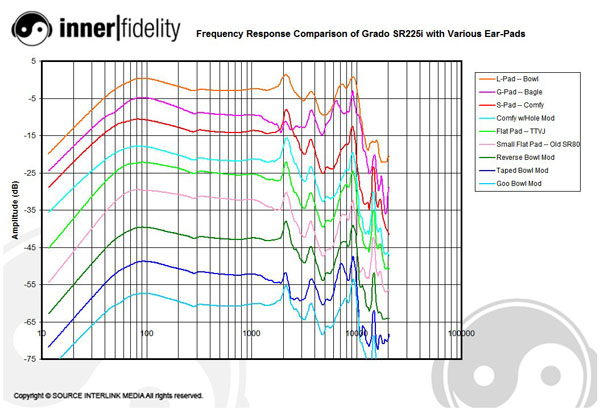| Columns Retired Columns & Blogs |
Evaluation of Grado Stock and Modified Ear-Pads Page 2

Playing with the Sound
Grado headphones tend to have a sound that you either love or hate. I'm afraid I fall into the latter camp, but I know lots of folks who's opinions I respect that are Grado lovers. So, please take my criticisms with a grain of salt.
Grado headphones tend to have a sound that you either love or hate. I'm afraid I fall into the latter camp, but I know lots of folks who's opinions I respect that are Grado lovers. So, please take my criticisms with a grain of salt.
To my ears, Grados generally have two faults: the bass lacks authority; and there's a harsh spot in the low-treble around 2kHz. Fortunately, it appears that playing with the pads does indeed effect the sound mildly, and both problems above can be tinkered with.
I'll be mentioning some of the other measurements taken, if you would like to follow along, please view or print the .pdf booklet of all the Grado headphones measured here. The booklet contains full measurement data sheets for all the cans in this review, but also has specs for the RS1, RS2, SR325i, SR325, SR125i, HF-2, HF-1 #69, and HF-1 first prototype.

This graph shows the frequency response of the Grado SR225i with the various pads. All measurements were taken at the same level, but offset for better readability.
The orange trace on top shows the Grado SR225i with its stock L-cushion. Note the peak at 2kHz; I believe this to be the blip that offends by making Grados harsh sounding to some. My listening notes read, "barky attack; lacks low bass and mid-range warmth; overly accentuates upper vocal registers."

In the 300Hz square wave of the SR225i with stock pads above, note the strong spike at the leading edge that spikes fairly high and returns almost to its starting point before moving upward to square wave top. The remaining noisiness at the top is rather normal and there's little ringing at any particular frequency.
The next trace down (light purple) on the FR chart is the G-cushion (bagle, salad bowl). Note the mid-range is dished downward overall, and is without the 2kHz blip. My listening notes say, "less barky; smoother mids; less bass slam, and tizzy highs." Let's look at the square wave.

ZING! Yeah, that looks like a tizzy high to me. I'm not sure what's going on here exactly, but those pads can make a big difference. It did seem to me like the harshness was less, even though the zing was there.
Moving on, we see the red trace which is the SR225i with the S-cushion (comfy pad). Here you'll note a very similar look to the top trace, with the exception that after the 2kHz bump it rolls off rather more quickly. I mentioned, "less lively; more closed, boring; poorer imaging, less air," in my listening notes. I didn't like the comfy pads much.

You can see that the comfy pad 300Hz square wave is a little slower looking --- not as much high frequency energy --- and it's ringing some, though at a lower frequency than the "salad bowls."
If you carefully inspect the full datasheets for the S-cushion (comfy pad)with hole mod (aqua trace) against the stock comfy pads, you'll see that it made little measurable difference; and I heard little difference in my listening tests.
The next two pads sounded quite similar: the TTVJ flat pad (lime green on chart), and the small flat pad from the old SR80 (pink). Both these pads had similar sound signatures, somewhat nicely in between the bowl and comfy pads. "Less barky, smoother; less articulate; less punch; poorer imaging" says my listening notes about the comfy pads relative to the bowls. And the smaller flat pad was another bit closer to the comfy's sound. I'll let you look up the square waves in the .pdf, not much to say.
And now to the modifications!
- Log in or register to post comments




































